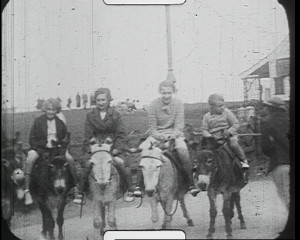
A film featuring various activities in the city of Clacton UK.
"A film about Cadgwith, a small village in the UK. The film was started in 1939 but the intervention of war prevented completion." (EAFA Database)
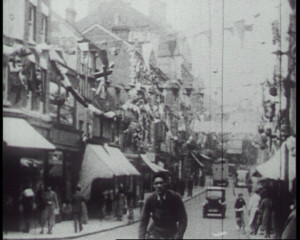
"The street decorations in Colchester for the Coronation of His Majesty King George VI. Flags, flowers and bunting adorn the streets, shops and public buildings of Colchester" (EAFA Database).
"Esther Cooke presents an outstanding motion picture. This colorful pageant, filmed against a background of majestic Austrian Alps satisfies in every respect. A masterful eye for beautifully composed scenes is evident throughout the film. The pageant is covered from such a variety of angles, one marvels at Esther Cooke's ability to record the vent single handed. The accompanying musical background and very informative narration are obviously the result of careful research and planning. Leo J. Heffernan narrates the film - truly a masterpiece among travelogues." PSA Journal, Dec. 1955, 34.
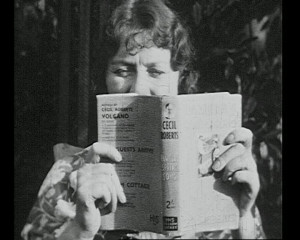
"The first film produced by Laurie and Stuart Day in which they presented their holiday footage with a 'prologue and epilogue' and, if possible, with a theme. In this example, holiday footage taken by Laurie and Stuart Day in the Austrian Tyrol is prefaced by and concludes with scenes featuring Laurie and Stuart Day at home in Stoke on Trent in Staffordshire"(EAFA Database).
"[W]e read about the desirability of giving one’s holiday films shape. So since then all our efforts have had a prologue and epilogue, and if possible a theme […]. This was first noticeable with a film of Austria called The Countess Receives, which was the result of reading a charming romance by Cecil Roberts developed from an advertisement by an Austrian Countess offering paying guests to her castle: “Sun, wild flowers, warm bathing, and dancing in the moonlight”. As I actually saw this advertisement shortly after reading the book it naturally suggested the framework of the resultant “visit” (Day 1958).
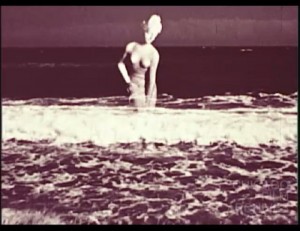
"A short travelogue film on the Republic of Cyprus. A narrator warmly introduces viewers to the charms, history and people of Cyprus." Chicago Film Archives.
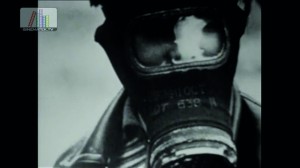
“1975 yılında yapılmıştır. İngiltere'nin İrlanda’daki sömürüsü, politik mahkumları, özgürlük mücadelesi hakkında 5 dakikalık bir filmdir. Dönemin görsel materyal azlığı koşullarında bol fotoğrafla ve az görüntülü bilgilendirme amaçlı bir filmdir.” Sinematek.tv: http://sinematek.tv/davut-ile-golyat/ (1 November 2019).
“It was made in 1975. This 5-minute-long film is about the British exploitation in Ireland, the political struggle [of the Irish people], and the fight for freedom. Because of the lack of visual material at the time of production, it purposefully benefits from the use of [the historical] photographs as counter-information.” Sinematek.tv: http://sinematek.tv/davut-ile-golyat/ (1 November 2019).

"Film record of a 14-day tour of Italian cities by train, including a day excursion to the island of Capri" (EAFA Database) "Sequences include shots of sightseeing attractions in Venice, Florence, Rome and Pompeii; street scenes in these cities; encounters with the local population, notably interactions with local children. Prefaced and concluded by domestic scenes at the Day’s home in Stoke on Trent, the film is a travel record of a trip to Italy in 1936/37. As noted in Laurie Day’s descriptions of the making of the film, the film’s narrative was inspired by the song 'Isle of Capri'. The travelogue contains humorous incidents involving Stuart and Laurie Day, culminating with the aborted assignation on Capri" (EAFA Database).
"This is a clever travel film, but it is also something more, because it introduces the personal note and contains humour. A husband dreams of Capri while he plays on his banjoline a song of the lovely island. The alluring features of a girl on the cover of the music become real and when his wife shows him details of a tour which includes Capri, he agrees to go. Then there is an ingenious sequence covering time and distance – for his hand winding up the gramophone merges into railway wheels – which again merge into him winding up his movie camera as he stands on the banks of a Venetian canal. Thereafter the film contains interesting and well-chosen shots of Venice, Florence, Pisa, Rome – each divided by a tourist label super-imposed over the railway wheels whizzing along. Some witty titles help the travel material, one, “Two of the ruins Rome knocked about a bit” introduces the man and his wife – both tired out – and she holds up her shoe in which is a large hole. Another touch ... a vast crowd in the arena wherein lions were released to Christians are running away – but not from lions, states the title and there follows a close-up of a large snail. A clever piece of assembling. The film ends in colour for the voyage to Capri – but the romance is not carried on as well as it might have been, because a girl the husband casually meets is not the same one who appeared on the music cover. However, the whole thing ends well with a title advising that if one cannot get what one wants, one should make do with what one has got! And some flowers are placed on a symbolic piece of music. A well-made travel picture that is instructive, humorous and sustains interest" (Anon 1938).
"This year my wife and I decided to make a joint film of our holiday instead, as previously, of competing with separate pictures on 16mm and 9.5mm. We decided to go to Italy immediately it was announced that train cruises were again running, although we both felt that such a highly organised trip, where every moment was planned and accounted for, was not the ideal holiday for making a film. We had to try and think of some sort of a story to hold our proposed film together and one day, while gazing reflectively into the kitchen sink, my wife heard me whistling the “Isle of Capri” and her imagination was not long in evolving the scenes with which our picture opens. It was left to me to arrange how the “romance” should be carried on and as there was neither time nor opportunity for a lengthy entanglement and any dream beauty could not be brought home as a souvenir, I decided to take my cue from the song itself – “fate hadn’t meant her for me” – and arrange for someone else to take over before the situation became difficult. We were particularly fortunate in this sequence in finding a girl and a man in our party who at a moment’s notice played the parts for us with but a single rehearsal. The sun was rapidly sinking behind buildings and had quite gone a few minutes after the shots were taken, and the remains of our colour film only just lasted out. Another thing we had to plan before starting was our transition from home to Italy and also between the various centres there. As the picture promised to be long enough in any case, we thought that luggage labels on which were superimposed revolving railway wheels would be brief and to the point. We had merely to remember to fade out on a typical scene of each town we visited and in the case of Venice to get a shot of myself winding up the camera to join up with the sequence commencing with my winding up the gramophone. In a country so prolific of architectural beauty, it was inevitable that we should overload ourselves with still camera material and for this reason we decided not to film Florence, but my wife so regretted this that on the morning of departure she rose at 6 am to take the scenes featured in the picture, hence the heavy shadows on the river. When all our material was assembled for editing and rolls had been discarded, it was still too heavy with scenic stuff and we had to think of more personal incidents to lighten it. A worn out shoe gave us the idea for “Two of the ruins that Rome had knocked about a bit.” This sequence was not taken in Rome but at a ruined Abbey in Wales and a few disconnected shots of myself with children and one of a cafe scene were worked into an incident with the aid of two additional shots taken at home. The superimposition of a girl’s head on a piece of music while it dissolved from cover to interior was taken four times. Trouble arose with the label sequences on account of a temperamental clockwork train which either went mad or stopped dead in the middle of a shot and resulted in three re-takes being necessary. Re-takes also account, in the opening shots, for the fact that my wife brings me a holiday folder in August and returns happily to her seat towards the end of November, but the difference in vegetation is hardly noticed. It took us months to complete the picture, by which time we were nearly as sick of it as we were with one another, but needless to say, an Amateur Cine World Plaque has more than restored our connubial harmony and we look forward to competing again next year" (Day 1938).
Total Pages: 15